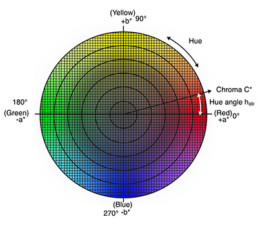Understanding the CIE L*C*h Color Space
The L*C*h color space, similar to CIELAB, is preferred by some industry professionals because its system correlates well with how the human eye perceives color. It has the same diagram as the L*a*b* color space but uses cylindrical coordinates instead of rectangular coordinates.
In this color space, L* indicates lightness, C* represents chroma, and h is the hue angle. The value of chroma C* is the distance from the lightness axis (L*) and starts at 0 in the center. Hue angle starts at the +a* axis and is expressed in degrees (e.g., 0° is +a*, or red, and 90° is +b, or yellow).
L* = lightness
C* = chroma
h = hue
Color measurement instruments make quantifying these color attributes easy. They determine the object’s color within the color space and display its values for each coordinate L*, C*, and h.
Color Differences: How Closely Does the Sample Match the Standard?
Even if two colors look the same to one person, slight differences may be found when measured with a color measurement instrument. If the color of a product does not meet the standard, customer satisfaction is compromised and the amount of rework and costs increase. Because of this, identifying color differences between a sample and the standard early in the process is important.
Color difference is defined as the numerical comparison of a sample to the standard. Referred to as Delta (Δ), it indicates the differences in absolute color coordinates. Deltas for lightness (ΔL*), chroma (ΔC*), and hue (ΔH*) may be positive (+) or negative (–).
ΔL* = difference in lightness and darkness (+ = lighter, – = darker)
ΔC* = difference in chroma (+ = brighter, – = duller)
ΔH* = difference in hue
Color measurement instruments can detect differences indiscernible to the human eye and then instantly display these differences in numerical form or on a spectral reflectance graph. After identifying color differences using L*C*h values, it should be decided whether the sample is acceptable or not.
Color Tolerances: Is the Color Difference Acceptable?
A color tolerance is a limit to how big the difference in color between a sample and the standard is allowed to be for the sample to be considered acceptable. Tolerances typically should be established for each component ΔL*, ΔC*, and ΔH* to identify which coordinate, if any, has exceeded the limit. The tolerance values create a wedge-shaped box around the standard. Color that falls inside this box is considered acceptable, while color that falls outside of this box is rejected.
Color that falls near the edge of this tolerance box may be numerically acceptable but visually unacceptable to the observer, however. Using ΔL*, ΔC*, ΔH* values and calculated weighting factors, the CIE2000 color difference formula was later established to address this weakness. Its formula more closely aligns with how the human eye sees color and provides higher accuracy, creating an ellipsoid around the standard within the color space. Color that falls inside this ellipsoid is considered acceptable, while color that falls outside of this ellipsoid is rejected.
This article is part of the foundation of color science. To learn how to measure color differences please Download our Whitepaper: Colorimetry
Want to learn more about color measurement? Join us for a two-part webinar series this May (2022) about the essentials of color science and the elements of an effective color process within research and manufacturing environments.










